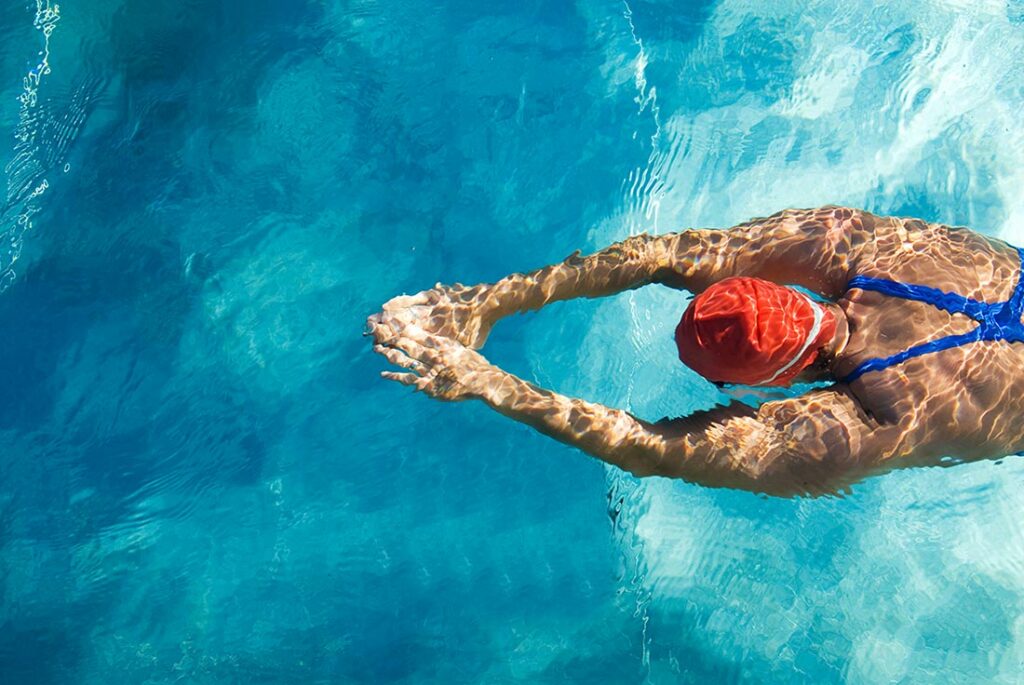If you associate swimming with sunny vacations or something just for kids, you’re missing out on a seriously good form of exercise. We’re not talking splashing round the pool, floating on your back and generally relaxing. (Though we love that too.) Swimming as a workout, can blow many of your favorite exercises right out of the water.
The Advantages of Swimming
Swimming is an incredible form of cardiovascular exercise that uses all of your major muscles.1 However, swimming isn’t just a great whole-body exercise, it’s also super easy on the joints. This makes it ideal if you’re looking for joint-friendly workout.2 Swimming tones, strengthens and conditions the body sans the jarring, unforgiving impact of other exercises.
Swimming also makes for an awesome cross-training activity, which can help to improve overall health and fitness, and reduce the risk of overuse injuries.3 For example, swimming is a great form of active recovery for runners. A swimming workout adds variety and allows runners to perform cardiovascular exercise whilst giving tired legs a break. It also calls for different movement patterns, targeting muscle groups runners tend to neglect and helping to build a more balanced body.4
Get ready to suit up and turn your gentle, leisurely meander in the pool into an athletic endeavor.
Fitness
How to Make Swimming a Workout
The more time you spend in the pool, the better you’ll get, the more you’re going to love it. So, without further ado, here’s how to get fit and make swimming a seriously effective workout.
1
Swim with good form
Water is much denser than air and so you need to try and carve through it like a hot knife through butter. Poor aqua-dynamics means that each meter you swim will take more effort because of increased water resistance. The more economically you can swim the easier it gets, and the further you can swim.
Practicing good technique also works the body’s muscles more evenly and promotes muscle balance.
Use swim tools to focus on specific aspects of your stroke and add variety to your workouts:5
- Fins – improve swimming leg strength and ankle flexibility (not just for snorkeling on holiday)
- Pull buoy and hand paddles – improve core rotation and arm strength.
- Kickboards – increase swimming leg strength.
Improving your technique won’t just make you faster, but will make swimming more enjoyable and increase the fitness benefits.
Related Guide

How To Exercise With Proper Form
Good form makes you more graceful in the water and allows you to propel yourself forward with less effort. Learn a few simple tips and tricks to improve your swimming form, and glide through the water like a fish.
2
Build endurance
If you haven’t been swimming for a while, it’s easy to forget quite how challenging swimming can be. And just like any other form of exercise, you have to work on improving technique and building endurance, i.e. swimming further.
A great way to swim longer is to practice steady-pace workouts, as well as interval training.6 Interval training involves alternating between faster and slower (recovery) periods of swimming. It works by stressing the body in multiple short, intense bursts. An example of interval training would be to swim one length (for most pools this is 25 yards or meters), then rest for 30 seconds, and repeat four times.
Longer intervals of 100, 200 and 300 meters at moderate intensity with short recovery periods improve endurance (aerobic workout). Start with shorter intervals, and as your fitness improves try longer ones. On the other hand, high-intensity sprinting intervals of 25 and 50 meters with long recoveries build speed and power (anaerobic workout).
Swimming further and stronger takes time, perseverance and patience. Take it easy; don’t overdo it, but push yourself and build steadily week on week.
3
Don’t just swim – train
Swimming is great exercise but only if you go into the water with a plan. Break your workout down into sections:
- warm up
- technique drills (to isolate and improve particular parts of your stroke)
- main session
- cool down.
4
Variety
Practice using a variety of strokes and use them to break up your workout. Different strokes use different muscle groups.
Although the front crawl (freestyle) should be your “go to” stroke, the breaststroke, the backstroke and even butterfly all have their place. Use these strokes in your warm up, cool down, and the recovery periods between harder bouts of swimming freestyle.
Front crawl (freestyle). The elongated body position and low profile in the water means that front crawl allows you to travel further, faster with less effort. Excellent for high-intensity workouts.
Breaststroke. Allows you to perform it with your head out of the water, making breathing easier. However, the high chest/ low legs posture characteristic of the breast stroke means that there is a lot of drag to overcome, resulting in a slower pace. Uses a completely different movement pattern and a great way to spice up your workout.
Backstroke. Allows you to go relatively fast and also keeps your face above water. It’s useful for recovery periods between intense work intervals.
Butterfly. Most technical and difficult swimming stroke to master. It’s also the most exhausting.
Related Guide

Beginner’s Guide to the Different Swimming Strokes
Master the basics and learn how to improve your swimming form with technique tips for each of the four main swimming strokes.
5
Swimming in lanes
Nothing can ruin your flow more than having to dodge people swimming widths while you are swimming lengths. Swim when the pool is divided into lanes so you can focus on swimming up and down in a straight line rather than zig-zagging.
Below are a few etiquette tips for swimming in lanes:7
- Pace. Lanes may be marked fast, medium, or slow. Take a minute observe the different lanes and gauge the speed, then choose a lane with people swimming your pace.
- Sharing a lane. Before jumping into a lane, check if you can share it. If there is only one person then “split the lane” with them – wait until they get to the other end of the lane, so you swim in opposite directions. If there are more people, check if they will “circle swim” – swimming clockwise in a circle, ensuring there is sufficient space in front and behind you. If you are swimming at a similar pace you should barely notice anyone in your lane.
- Overtaking. Foot tapping is the swimmers gesture of indicating they want to pass. Gently touch the toes of the swimmer in front to signal you want to overtake. Pass on the left (United Kingdom and Australia pass on the right). If you’re at the end of the lane, they will pause there and allow you to pass. If you get tapped, do likewise.
- Pre-emptive action. If a swimmer is slightly faster, don’t start a new lap if they are just behind you. Let them go first, wait about 5 seconds, and you should avoid running into each other for the rest of your workout.
- Rests. When taking a break, keep close to the wall and the corner, giving the other swimmers space to turn and push-off.
6
Hydrate
Although you probably don’t realize it, you lose water when you are swimming. During land-based workouts, you feel the heat and see the sweat, and you know you should drink more water. When you’re swimming you don’t get these cues as clearly. You don’t feel as hot and you’re already wet. However, exhaled air contains a lot of water and, though washed away instantly, you also sweat. Also, if you swim in warmer water, you sweat more (just like land-based exercise on a warmer day).8
Take a sports bottle with you and hydrate as you would during any land-based workout.
7
Join a swimming club
Swimming clubs offer structured workouts and coaching, which will improve your technique, identify weaknesses, and build on your strengths. Meeting other athletes is motivating, and turns a sometimes solitary activity into a more social one. There are meets in which you can compete, providing a competitive outlet for your fitness and giving new focus.
Beginners are always welcome and many clubs offer masters swimming (swimmers aged 25 and over) sessions as well as beginner and improver lessons.
Swimming is as tough on the upper body, as it is on the lower body. It is a challenging cardiovascular workout and it’s intense strength training. It’s high-intensity, but it’s low-impact. Swimming can reduce the risk of suffering with chronic illness, lower the risk of death, and improve mood.9‘10‘11
In other words, you’ll be hard pressed to find a workout that is as holistic as swimming. And on a hot summers day, taking your workout to a cool, refreshing pool is just the cherry on top.

